Asics Bundle
Who Really Owns ASICS?
Understanding the ownership structure of a global brand like Asics SWOT Analysis is crucial for investors and business strategists alike. The evolution of Asics ownership, from its humble beginnings to its current status, reveals much about its strategic direction. This exploration will uncover the key players and influences that have shaped the Asics company over time.
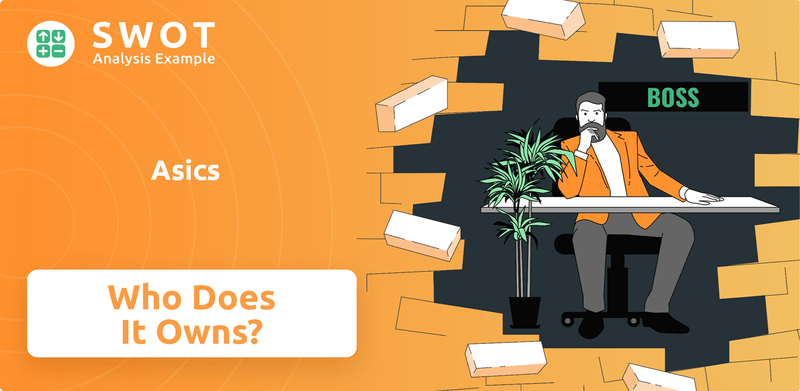
Founded in Japan in 1949 by Kihachiro Onitsuka, the Asics corporation has transformed from a local manufacturer into a global powerhouse. This analysis of Asics ownership will examine the shifts in power and the impact of major shareholders. Discover the answers to questions such as: Who owns Asics shoes? Who controls Asics? Is Asics a publicly traded company?
Who Founded Asics?
The story of the Asics company began on September 1, 1949, with the establishment of Onitsuka Co., Ltd. in Kobe, Japan. This company was founded by Kihachiro Onitsuka. His initial vision was to uplift the spirits of post-war Japanese youth through sports by manufacturing basketball shoes.
While specific equity details from the company's inception are not publicly available, Kihachiro Onitsuka is recognized as the sole owner of the original Onitsuka Co., Ltd. This marked the beginning of what would evolve into a global athletic brand.
Early in its history, Onitsuka Co., Ltd. formed a significant partnership with Blue Ribbon Sports, which later became Nike, Inc. This early collaboration was crucial for the international distribution of Onitsuka Tiger shoes.
The evolution of Asics ownership involved several key milestones, beginning with its founder, Kihachiro Onitsuka. The company's structure shifted over time, reflecting its growth and strategic decisions.
- Founding: Kihachiro Onitsuka established Onitsuka Co., Ltd. in 1949, initially focused on basketball shoes.
- Early Partnership: A distribution agreement with Blue Ribbon Sports (Nike) in 1963 expanded the reach of Onitsuka Tiger shoes.
- Merger and Formation of Asics Corporation: In 1977, Onitsuka Co., Ltd. merged with GTO Co., Ltd. and JELENK Co., Ltd., leading to the formation of Asics Corporation. Kihachiro Onitsuka became the president of the newly formed entity.
The merger in 1977 broadened the scope of the Asics brand, moving beyond footwear to include a wider array of sporting goods, with Kihachiro Onitsuka at the helm. This strategic move was a key step in establishing the company's presence in the global market.
Asics SWOT Analysis
- Complete SWOT Breakdown
- Fully Customizable
- Editable in Excel & Word
- Professional Formatting
- Investor-Ready Format
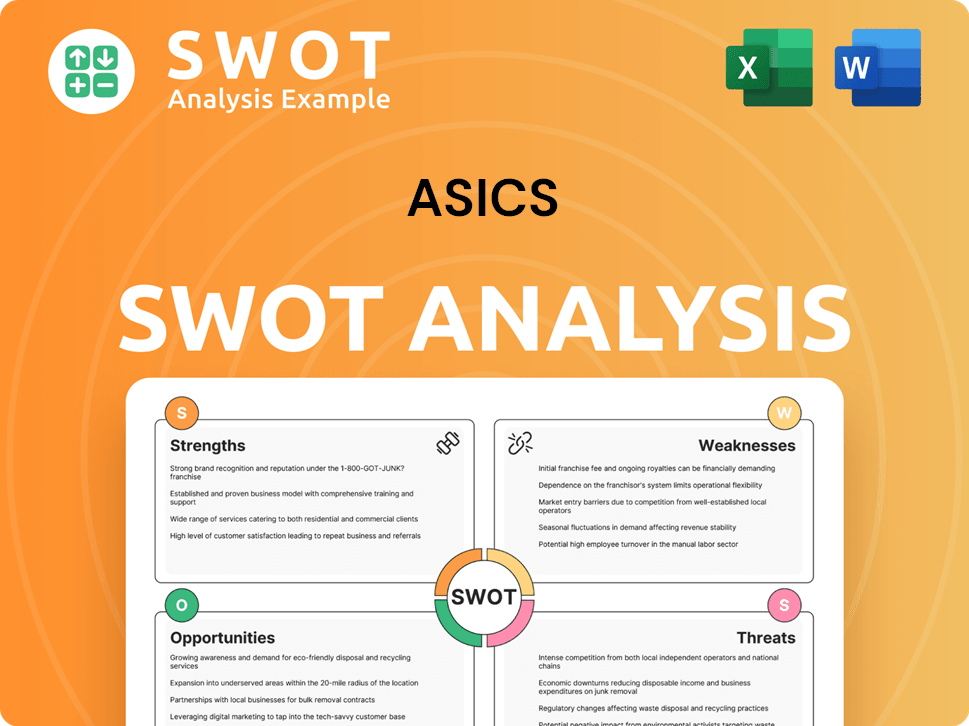
How Has Asics’s Ownership Changed Over Time?
The
Asics
Corporation, a publicly traded entity on the Tokyo Stock Exchange (TYO: 7936), has a dynamic ownership structure. As of December 31, 2024, the company had a total of 759,482,236 issued shares, with 43,740,506 treasury shares. The market capitalization of the
Asics
company
was approximately $17.4 billion USD as of June 12, 2025. This structure reflects a blend of institutional and individual investors, impacting the company's strategic direction and governance.The evolution of
Asics
ownership
is marked by strategic moves to enhance shareholder value. In 2024, the company undertook equity offerings aimed at reducing the influence of policy-held shares. This initiative, along with share buyback programs in March and August 2024, and February 2025, aligns with the Mid-Term Plan 2026, targeting a total shareholder return exceeding 50%. Furthermore, the announcement in July 2024 to sell all cross-holding shares underscores a commitment to improving capital efficiency and attracting a diverse investor base. These actions are crucial in shaping theAsics
company
ownership
structure
and its approach to governance.| Shareholder | Percentage of Shares (as of) | Approximate Shares Held |
|---|---|---|
| Nomura Asset Management Co., Ltd. | 5.28% (May 14, 2025) | 37,454,075 |
| The Vanguard Group, Inc. | 3.41% (April 29, 2025) | 24,172,622 |
| Nissay Asset Management Corporation | 3.20% (December 30, 2024) | 22,716,000 |
| Sumitomo Mitsui Financial Group Inc., Asset Management Arm | 3.09% (August 14, 2024) | 21,946,040 |
| GIC Private Limited | 3.05% (December 30, 2024) | 21,638,000 |
| JP Morgan Asset Management | 2.47% (April 29, 2025) | 17,541,723 |
| Norges Bank Investment Management | 2.35% (December 30, 2024) | 16,637,000 |
| Individual Shareholders | Approx. 9.4% (December 31, 2024) | N/A |
The
Asics
brand
has a richAsics
history
, and understanding its ownership is key to grasping its current position. Major institutional investors, such as Nomura Asset Management Co., Ltd., The Vanguard Group, Inc., and Nissay Asset Management Corporation, hold significant portions of the company's shares. These stakeholders, along with individual shareholders, shape the strategic direction of theAsics
company
. For more details on the company's origins, consider reading a Brief History of Asics.The
Asics
company
is publicly traded with a diversified ownership structure, primarily held by institutional investors.- Nomura Asset Management Co., Ltd. is a major shareholder.
- The company is actively optimizing its capital structure to enhance shareholder value.
- Strategic moves, such as equity offerings and share buybacks, are ongoing.
- Individual shareholders make up a notable percentage of the ownership.
Asics PESTLE Analysis
- Covers All 6 PESTLE Categories
- No Research Needed – Save Hours of Work
- Built by Experts, Trusted by Consultants
- Instant Download, Ready to Use
- 100% Editable, Fully Customizable
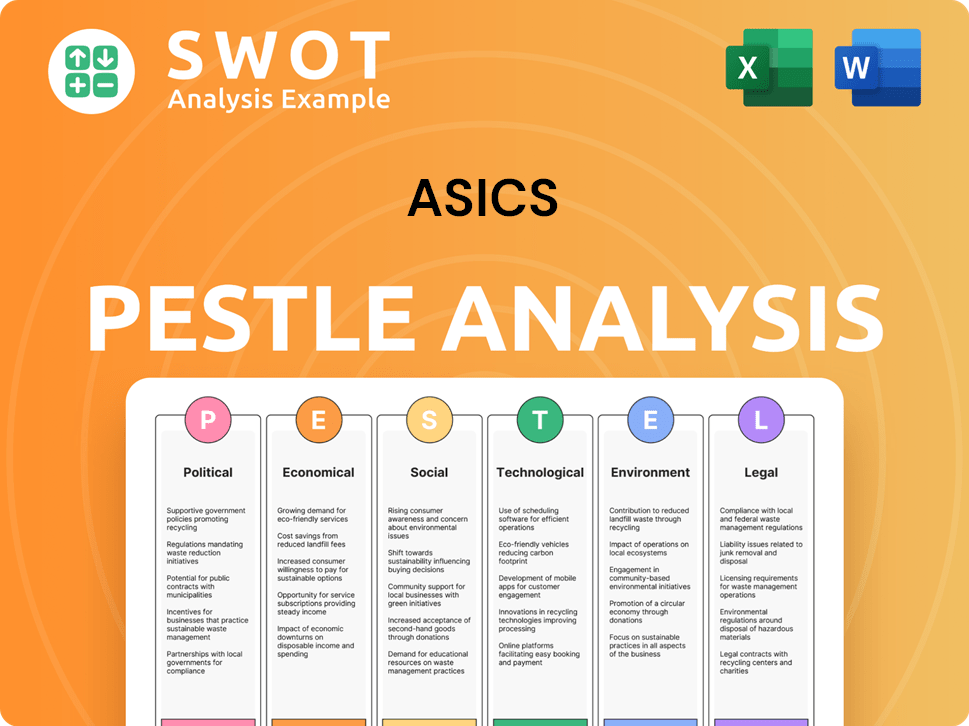
Who Sits on Asics’s Board?
The Board of Directors at the Asics Corporation is pivotal in guiding the company's strategic direction and safeguarding shareholder interests. The leadership structure includes a Chairman and CEO, who also serves as a Representative Director. The board comprises various members, including executives and independent directors. For example, Motoi Oyama serves as Chairman and CEO, and Yasuhito Hirota as President. The company focuses on clear communication from its executives regarding management strategy and detailed business disclosures to facilitate investor dialogue.
Asics company has been recognized for its investor relations efforts, receiving the 'Best IR Award' and 'Kyokan! IR Award' in both 2023 and 2024 from the Japan Investor Relations Association. These awards highlight the company's commitment to transparency and enhancing corporate value. The company's recent focus on increasing individual shareholders and deepening dialogue with institutional investors shapes its decision-making processes.
| Board Member | Title | Notes |
|---|---|---|
| Motoi Oyama | Chairman and CEO, Representative Director | Oversees overall strategy and operations. |
| Yasuhito Hirota | President | Focuses on day-to-day management and operations. |
| Other Directors | Various | Include executive and independent directors. |
The Asics brand emphasizes its commitment to corporate governance and transparency, as evidenced by its investor relations awards. The company strives to improve corporate value by increasing the number of individual shareholders and enhancing communication with both domestic and international institutional investors. For more insights into the financial workings of the company, you can explore the Revenue Streams & Business Model of Asics.
Who owns Asics? The company is structured with a board of directors that includes executive and independent members. The leadership includes a Chairman and CEO, along with a President. Asics corporation prioritizes clear communication and transparency with investors.
- Motoi Oyama serves as Chairman and CEO.
- Yasuhito Hirota is the President.
- The company has won awards for its investor relations.
- Asics company ownership structure focuses on enhancing shareholder value.
Asics Business Model Canvas
- Complete 9-Block Business Model Canvas
- Effortlessly Communicate Your Business Strategy
- Investor-Ready BMC Format
- 100% Editable and Customizable
- Clear and Structured Layout
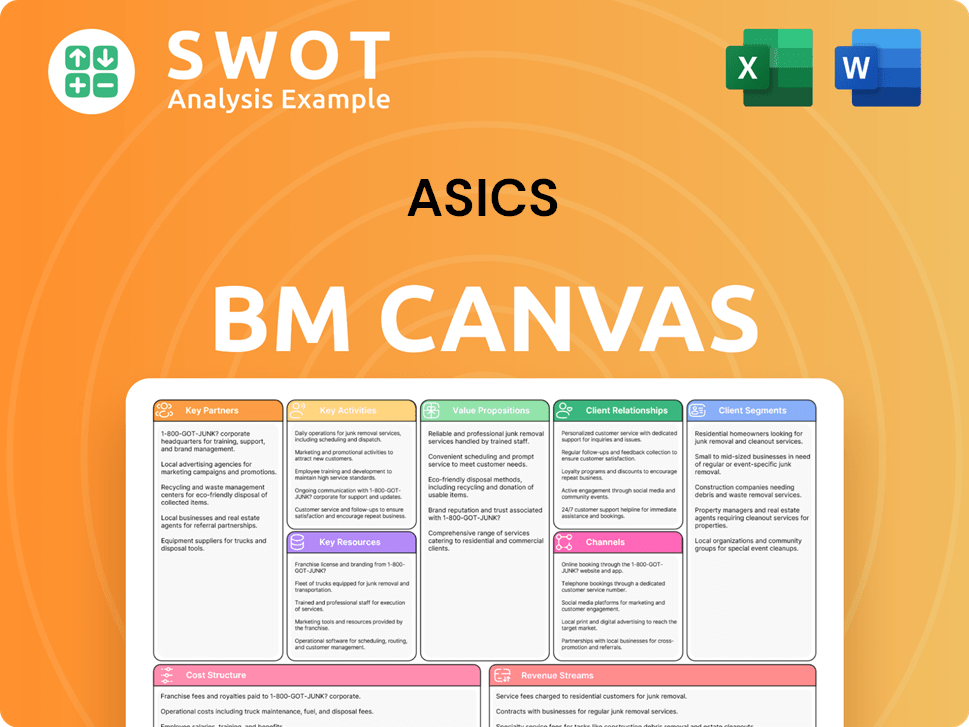
What Recent Changes Have Shaped Asics’s Ownership Landscape?
Over the past few years, Asics's ownership has been actively managed through strategic initiatives. These efforts aim to boost shareholder value and improve capital efficiency. A key trend is the company's use of share buybacks. In August 2024,
Another significant development involves Asics's plan to sell all cross-holding shares. This was announced in July 2024, along with a secondary offering of shares held as cross-holding by other companies. The cancellation of 25 million treasury shares in February 2025 (representing 3.29% of outstanding shares before cancellation) further demonstrates Asics's commitment to reducing future share dilution and improving its capital market standing. These moves have generally led to positive responses in the stock price. The company's focus on a diverse investor base and proactive capital management highlights its forward-looking approach to its ownership structure and corporate value.
Industry-wide trends, like increased institutional ownership, are evident in Asics's shareholder base. Major institutional investors hold significant percentages. Asics has also sought to attract domestic individual investors through advertising and engagement strategies, particularly after a stock split and secondary offering in 2024, which led to a significant increase in individual shareholders. This approach reflects Asics's commitment to a strong and varied investor base and its proactive management of its capital.
Asics has actively engaged in share buybacks to enhance shareholder value. In August 2024, a plan to repurchase up to 10 million shares was announced. This was completed by August 31, 2024, with approximately JPY 9.887 billion spent on acquisitions.
Asics's Mid-Term Plan 2026 aims for a shareholder return of over 50%. This commitment underscores the company's focus on delivering value to its investors through strategic financial actions.
Asics plans to sell all cross-holding shares and has canceled treasury shares. This indicates a move to alleviate concerns about share dilution. These moves are intended to improve its standing in the capital market.
Asics is focused on attracting a diverse investor base, including domestic individual investors. This is achieved through creative advertising strategies. The company aims to strengthen engagement with its investors.
Asics Porter's Five Forces Analysis
- Covers All 5 Competitive Forces in Detail
- Structured for Consultants, Students, and Founders
- 100% Editable in Microsoft Word & Excel
- Instant Digital Download – Use Immediately
- Compatible with Mac & PC – Fully Unlocked
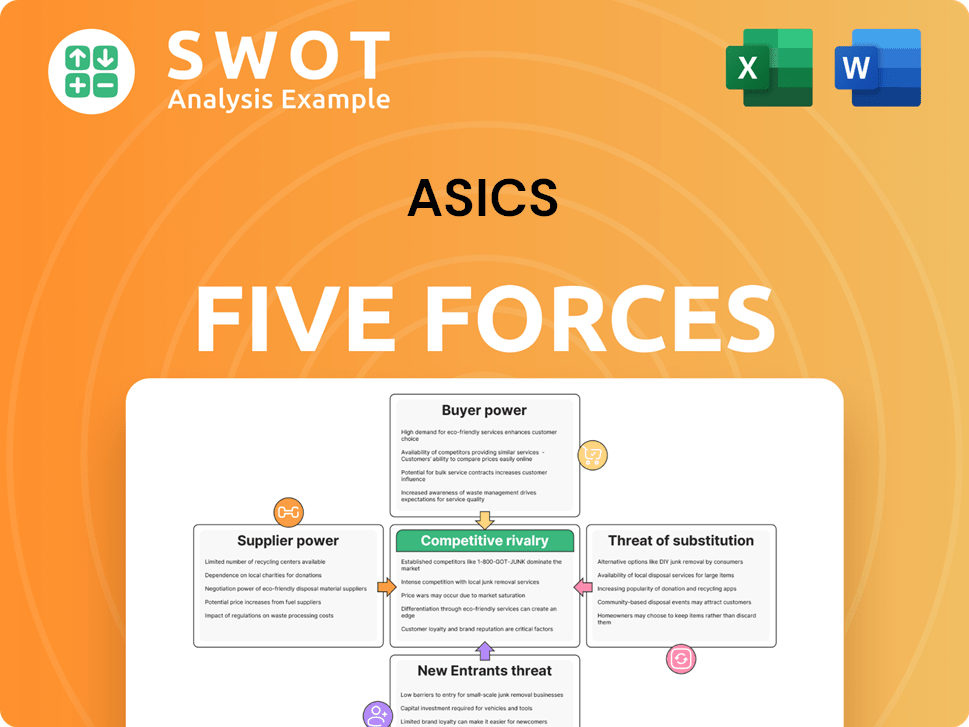
Related Blogs
- What are Mission Vision & Core Values of Asics Company?
- What is Competitive Landscape of Asics Company?
- What is Growth Strategy and Future Prospects of Asics Company?
- How Does Asics Company Work?
- What is Sales and Marketing Strategy of Asics Company?
- What is Brief History of Asics Company?
- What is Customer Demographics and Target Market of Asics Company?
Disclaimer
All information, articles, and product details provided on this website are for general informational and educational purposes only. We do not claim any ownership over, nor do we intend to infringe upon, any trademarks, copyrights, logos, brand names, or other intellectual property mentioned or depicted on this site. Such intellectual property remains the property of its respective owners, and any references here are made solely for identification or informational purposes, without implying any affiliation, endorsement, or partnership.
We make no representations or warranties, express or implied, regarding the accuracy, completeness, or suitability of any content or products presented. Nothing on this website should be construed as legal, tax, investment, financial, medical, or other professional advice. In addition, no part of this site—including articles or product references—constitutes a solicitation, recommendation, endorsement, advertisement, or offer to buy or sell any securities, franchises, or other financial instruments, particularly in jurisdictions where such activity would be unlawful.
All content is of a general nature and may not address the specific circumstances of any individual or entity. It is not a substitute for professional advice or services. Any actions you take based on the information provided here are strictly at your own risk. You accept full responsibility for any decisions or outcomes arising from your use of this website and agree to release us from any liability in connection with your use of, or reliance upon, the content or products found herein.